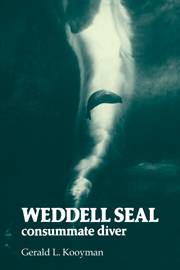Book contents
- Frontmatter
- Contents
- Preface
- Dedication
- Map
- 1 McMurdo Sound
- 2 The Weddell seal
- 3 Breeding, birth, and growth
- 4 Cold
- 5 Diving behavior: Poseidon's pride
- 6 Physiology of diving
- 7 Food habits and energetics
- 8 Under-ice orientation (summer day – winter night)
- 9 Distribution, abundance, and mortality
- 10 Future prospects
- References
- Index
8 - Under-ice orientation (summer day – winter night)
Published online by Cambridge University Press: 21 May 2010
- Frontmatter
- Contents
- Preface
- Dedication
- Map
- 1 McMurdo Sound
- 2 The Weddell seal
- 3 Breeding, birth, and growth
- 4 Cold
- 5 Diving behavior: Poseidon's pride
- 6 Physiology of diving
- 7 Food habits and energetics
- 8 Under-ice orientation (summer day – winter night)
- 9 Distribution, abundance, and mortality
- 10 Future prospects
- References
- Index
Summary
Any error in brachiating from branch to branch could be fatal. Every leap was an opportunity for evolution.
Carl Sagan, The Dragons of EdenThe problem of under–ice orientation in Weddell seals is essentially a dual one because of the difference between deep, feeding dives and exploratory dives. Not only is there a dual behavioral relationship, but because of the great difference between summer and winter environmental conditions the seasonal physical conditions should be considered separately as well.
What physical clues and modes of perception are most important and how the seal develops its skills both might be better understood by comparing two types of dives. Navigation to and from the breathing hole during deep dives would seem to be less demanding than navigation during exploratory dives. The deep dive is of much shorter duration and distance, and there is always the directional constant that the hole is somewhere above the seal. Conditions would seem to be much more rigorous during exploratory dives. There is no dependable direction to the breathing hole, and the distance from the hole and duration of the dives is much greater.
The sea in which the seals must perform is always changing. A good time to begin a discussion of the sea conditions in McMurdo Sound is with the month of October. Not only is it a month when winter officially ends for the United States Antarctic Research Program (USARP) and support flights begin to bring in fresh personnel and supplies, but it is also the time that near–term female Weddell seals arrive in numbers.
- Type
- Chapter
- Information
- Weddell SealConsummate Diver, pp. 86 - 108Publisher: Cambridge University PressPrint publication year: 1981



